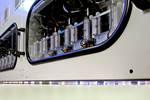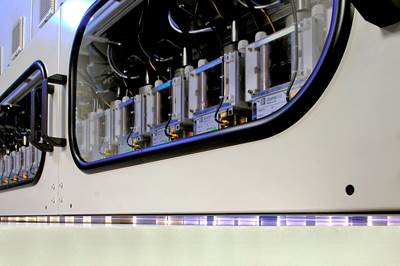Plasmatreat Technology Days 2025 celebrates 30 years of Openair-Plasma
More than 200 guests accepted the Steinhagen-based family business’ invitation to discuss new applications of atmospheric plasma systems in surface pretreatment.
Plasmatreat Technology Days 2025. Source (All Images) | Plasmatreat GmbH
July 2-3, 2025, Plasmatreat GmbH (Germany) celebrated the 30th anniversary of the patent application for its Openair-Plasma technology with Technology Days 2025 at its Steinhagen headquarters. Three decades ago, this process for pretreating surfaces with industrially compatible atmospheric plasma began Plasmatreat’s advance, and has since optimized numerous industrial processes worldwide thanks to its process stability, efficiency, environmental friendliness and ease of integration into production environments. This was the focus of the high-profile event, where 200 guests, 16 industry partners and the international sales team were present.
“The future of plasma technology has only just begun — as has our journey together. We are still at the beginning,” said Plasmatreat founder and CEO Christian Buske in his welcome speech. “Our tool is ionized gas. All of our applications use this tool to modify the structure of surfaces of a variety of materials specifically. Our plasma technology provides countless possibilities for modifying the surfaces of plastics, metals, glass, cardboard, films, fibers, composites and recycled materials. We use plasma technology to give these materials special properties for further processing.” These basic tasks include ultra-fine cleaning, activation, reduction and coatings for a wide range of industrial applications.
Read “Plasma moves beyond improved bonding to coatings, multifunctional composites”
“Think ahead, experience innovation” was the Technology Days motto. The agenda included a balanced mix of technical presentations, workshops and discussions at the exclusive partner exhibition. During workshops, Plasmatreat experts demonstrated how the company’s solutions are used.
Technical lectures, presentations
Hans Beckhoff, Dr. Joerg Ihde from Fraunhofer IFAM, Dr. Alexander Stoppa from Irlbacher, Peter Auerbeck from GROB-Werken and Gunnar Melles from tesa organized and presented technical lectures at the Plasmatreat Technology Center. During their presentations, the experts discussed the latest trends in developing new products at their companies and explained how they use Plasmatreat solutions. Beckhoff provided insights into the latest automation innovations, while Stoppa spoke about hardware designs for glass-based HMIs in harsh industrial environments. Auerbeck and Melles focused their presentations on battery production for e-mobility.
Eagerly awaited was the presentation by Buske. He reviewed the development history of Openair-Plasma technology, using the automotive industry as an example. The technology, he explained, originated from a joint project with a regional automotive supplier, in which both companies achieved a breakthrough in bonding headlights to polypropylene housings.
Plasmatreat demonstrations.
“Since then, we have collaborated closely with customers for over three decades to develop a wide range of solutions, from laboratory and standalone systems to fully automated lines,” said Buske. “Our portfolio of nozzles and nozzle heads alone includes many different variants for static or rotating systems for a variety of applications. This means that, even for new applications, we can often meet the requirements with existing solutions and minor adjustments.”
Plasmatreat technology is currently used in more than 100 automotive and battery production applications. “Since development processes in the automotive industry are particularly sensitive and data-intensive, we now comply with TISAX standards for information security,” added Buske. “This is a logical step for us and a clear signal to our automotive industry partners: Plasmatreat is reliable in more ways than one.”
Hands-on workshop sessions
Many visitors came to the workshops with ideas for new applications or drew inspiration from the examples of applications shown to optimize their companies’ production processes with Plasmatreat solutions.
To enable efficient work in the interactive workshops, Plasmatreat surveyed guests’ main interests before the Technology Days. This enabled guests to be divided into smaller groups, so that each guest received an individual program at the beginning of the event.
A total of eight workshops covered the current state and future of plasma technology in various application areas.
The workshop, “Perfect Images: Plasma for Demanding Printing Processes,” in the PT-Print room at Plasmatreat’s Technology Center is particularly noted. In addition to applications in packaging manufacturing and other areas, many participants found the production of a digitally printed, customized sports shoe to be a highlight of this workshop. The thermoplastic used in this process is activated with Openair-Plasma, which makes it ideal for printing with UV ink. Innovative nozzle technology in the form of a new nozzle for printing applications was also a focus.
Another workshop, “REDOX effect: Reduction to High-Performance Coatings,” showed how oxidized and contaminated metal surfaces are cleaned in the semiconductor industry to meet the strictest standards for manufacturing electronic components. Plasma systems and reduction were also demonstrated live.
The workshop, “Cleaning Reimagined: From Openair-Plasma to HydroPlasma,” showcased a Plasmatreat innovation that involves adding distilled water to a plasma jet, which enhances the plasma treatment’s effectiveness. Using small metal plates contaminated with fingerprints, the experts demonstrated that HydroPlasma can reliably remove even the most stubborn contaminants, such as oils, salts and fats, without the use of wet chemistry and in a manner that can be verified with measuring instruments.
As the title of another workshop in the main building, “Innovative Technology and Forward-Looking Coatings,” suggested, this event focused on PlasmaPlus PT-Bond, a technology that enables the application of ultra-thin coatings to materials by injecting gaseous precursors into plasma jets via plasma nozzles. The plasma, enriched in this way, then hits surfaces that were previously treated with Openair-Plasma technology, coating them with ultra-thin, transparent plasma polymer layers. These layers can include bonding agents for structural bonding, as well as barrier and insulation layers for corrosion protection. The workshop featured a thermoforming application in which sheet metal was coated with an ultra-thin protective layer instead of a film to prevent scratching. This is one example of many applications in which plasma technology can replace consumables, positively impacting operating costs and process sustainability.
As was made increasingly clear in the technical presentations, assembly bonding is becoming the preferred joining technology in an ever-growing number of industrial sectors. Lukas Buske’s example of the complete bonding of all car body elements demonstrated how far development has progressed in this area. Further impressive examples were discussed in the workshop, “Plasma Meets Polymer: Efficient Activation for Maximum Adhesion” in the Application Technology Laboratory.
Corrosion protection was also the subject of a separate workshop, “AntiCorr as a protective shield for surfaces.” This workshop took place in Plasmatreat’s contract service area, and demonstrated the process of cleaning and coating a customer’s battery housing made of aluminum die-cast and continuous cast aluminum with AntiCorr. For this purpose, a robot equipped with an Openair-Plasma nozzle and a PlasmaPlus nozzle was used. This process effectively protected the battery tray against crevice corrosion while using minimal precursors.
Plasmatreat’s plasma technology is now used in electronics, medical, aerospace, packaging and battery manufacturing industries, as well as numerous other sectors. A decisive factor for the company’s global customers is that Plasmatreat has a worldwide presence and is therefore close to them, with its representatives and approximately 320 employees.
Related Content
Master Bond features non-drop cryogenic epoxy
EP29LPSPND-3 is a two-component, electrically and thermally insulating epoxy compound with a paste consistency that can be used for bonding and sealing applications.
Read MoreIPS Adhesives debuts Scigrip SG2000 adhesive in North America
The adhesive’s 1:1 mix ratio and long open time provides transportation, construction and marine industries with much-needed routine simplification and flexibility.
Read MoreAnalySwift receives NASA STTR contract to enable second-use spacecraft infrastructure
Together with Purdue, AnalySwift aims to develop a composite heater layer and a novel software tool or module to achieve assembly, disassembly of thermoplastic composite joints in space during long-duration missions.
Read MoreTFP glass veils prove integral for fiber-metal laminate applications
A recent study conducted on vacuum-infused thermoplastic fiber-metal laminates has highlighted the performance benefits behind using TFP’s nonwovens for consistent, uniform bondlines and interfacial bonding.
Read MoreRead Next
VIDEO: Plasma surface treatment technology improves adhesion
Plasamatreat demonstrates its Openair-Plasma surface treatment technology, which can enhance material adhesion.
Read MoreAtmospheric plasma jet technology rapidly pretreats glass fiber honeycomb sandwich panels
Plasmatreat’s Openair-Plasma system provides composite honeycomb panel manufacturer, MonoPan Composites, with a reliable, high-speed and low-cost dry pretreatment solution for homogeneous wettability.
Read MoreCeramic matrix composites: Faster, cheaper, higher temperature
New players proliferate, increasing CMC materials and manufacturing capacity, novel processes and automation to meet demand for higher part volumes and performance.
Read More












